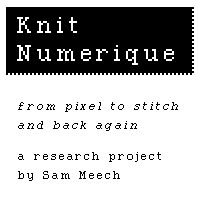
Currently available designs:
Alan Turing: “Machines take me by surprise with great frequency”
available in: black / white
Herbert Read: “Art is pattern informed by sensibility.”
available in: yellow / blue and purple / pink
NEW! (Oct 2018):
Ada Lovelace: “The Analytical Engine weaves algebraic patterns just as the Jacquard loom weaves flowers and leaves. Ada Lovelace 1843”
available in:
- apricot / navy LAST FEW
- grey / navy
- taupe (bronzey brown) / navy
All scarves are double jaquard (reverse design on the other side). They have been knitted on a 7-gauge machine and have a selvage on each side, and finished using the overlocker on each end. Alan Turing and Ada Lovelace scarves now have a label!
They are all just £20 each plus P&P (about £3.45 for UK, £6.20 to Ireland / EU, £12.95 to US). (If you’re in Manchester I’ll do my best to get it to you and save you the postage.)
give me a shout if you want one – email me at hello [@] smeech [dot] co [dot] uk

Ada Lovelace – navy / taupe

Ada Lovelace – navy / grey

Ada Lovelace – navy / apricot

Alan Turing – black / white

Herbert Read scarf – yellow / blue – also available in pink / purple

Detail – Ada Lovelace scarves now have labels!!
What are Binary Scarves?
BINARY SCARVES are a series of knitwear informed by the ASCII text system of encoding text to binary. Each design contains a quote related to either computers, binary, patterns, digital art or repetition. The designs are presented within the constraints of a standard 24-stitch punchcard pattern repeat. The scarves have been produced in collaboration with a factory in Manchester, ironically named Unique Knitwear.
The project began as a commission to create a data visualisation scarf telling the story of 25 years of the World Wide Web. It was presented to Sir Tim Berners-Lee (inventor of the World Wide Web) at the 2014 Open Data Summit. The www.scarf encoded a quote from his original 1989 CERN memo:
“The system must allow any sort of information to be entered. Another person must be able to find the information, sometimes without knowing what he is looking for”
This design process has since been explored further in collaboration with Unique Knitwear, Mcr (We worked on the Unique Editions exhibition together), producing a series of designs and colourways encrypt quotions about computation, pattern and digital aesthetics.
ASCII is an encoding system, known as an abbreviation for the American Standard Code for Information Interchange. Designed initially for old type computers and printers from telegraphic codes, it was based on 128 symbols including 10 numbers, 26 letters of English alphabet, a number of punctuation marks, etc. – from BinaryHexConvertor.com
The design of each scarf encrypts a quotation as a binary code, whereby each 8 stitches represents a letter from the alphabet, using a value ascribed to a character from the ASCII text alphabet. (You can find lots of text to binary convertors online).
01001101 01100001 01100011 01101000 01101001 01101110 01100101 01110011 00100000 01110100 01100001 01101011 01100101 00100000 01101101 01100101 00100000 01100010 01111001 00100000 01110011 01110101 01110010 01110000 01110010 01101001 01110011 01100101 00100000 01110111 01101001 01110100 01101000 00100000 01100111 01110010 01100101 01100001 01110100 00100000 01100110 01110010 01100101 01110001 01110101 01100101 01101110 01100011 01111001 00101110 00100000 01000001 01101100 01100001 01101110 00100000 01010100 01110101 01110010 01101001 01101110 01100111 00001101 00001010
(Machines take me by surprise with great frequency – Alan Turing)
At first the connection between Turing and knitting might not be apparent, but the development of textiles technology and computers go hand in hand. Jacquard looms were programmed using punchcards – a system that formed the interface for early computers. The notion of encoding information, patterns and functions on the punchcard applies to both technologies. Amazing fact: Brother, who made the domestic knitting machines that I use in workshops, and many other textiles machines for industry, are better known for producing computers and printers, and based their headquarters in Manchester in 1968. The parallels between textiles and computing are historic but also embedded in the design process itself – what is knitting but a digital system, only using stitches instead of 0s and 1s?
I enjoy using domestic knitting machines to give people a chance to get knitting but also learn about digital design. The machines themselves often attract the attention and curiosity of all ages. People either encounter them for the first time, or they have fond memories of a mother or grandmother knitting away on one. I found myself having many conversations with people about the mechanics, but also the opportunities for design that they offer. Each person brings their own skills and interests – from suggesting it could be a way of expressing data to archiving personal stories, or even writing music (echoing the way Ada Lovelace envisioned the potential of Babbage’s Analytical Engine’). The power of knitting is that it is disarmingly familiar, and so people feel qualified to make their own digital designs and encrypted knits. The added bonus of course is that you can wear your digital art.

